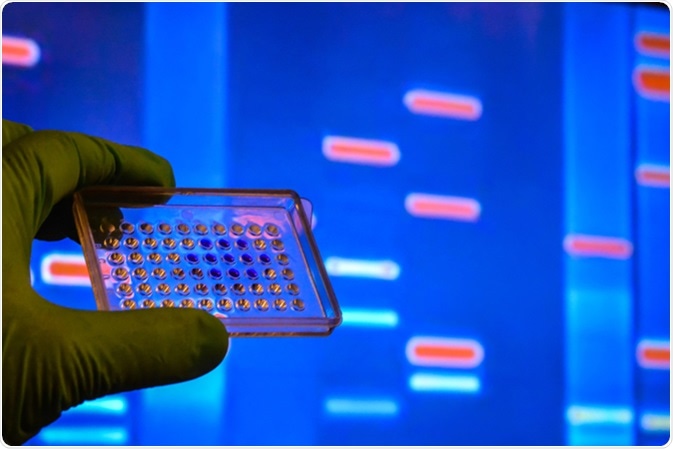Multiomics is a new approach where the data sets of different omic groups are combined during analysis. The different omic strategies employed during multiomics are genome, proteome, transcriptome, epigenome, and microbiome.
(Video 1 of 8) Introduction to Omics: 360 Degree View of You
Genomics
Genomics is a field which involves identification of genes and genetic variants associated with a disease or in response to certain drugs and medication. In this approach, GWAS or Genome Wide Association Studies are used to identify genetic variants in an entire genome which are associated with a disease.
Genotyping is performed for thousands of people for almost a million markers to identify significant differences in genetic markers between healthy and diseased individuals. Apart from GWAS, genotype arrays, next generation sequencing and exome sequencing are also applied in this approach.

Image Credit: Sergei Drozd / Shutterstock
Epigenomics
Epigenomics refers to identifying modifications of DNA or DNA-associated proteins. These include DNA acetylation/deacetylation and methylation. Cell fate and functions can be modified by modifications in DNA and histones, apart from genetic changes. These changes can be based on the environment and are passed onto progeny.
Epigenetic changes in genome can also act as markers for metabolic syndromes, cardiovascular diseases, and physiological disorders. These changes can be cell-and tissue-specific. Thus, it is critical to identify the epigenetic changes during native and diseased states. Next generation sequencing is also used to assess DNA modifications.
Transcriptomics
This approach is used to identify the qualitative and quantitative RNA levels in the whole genome. This includes which transcripts are present and the levels of their expression. Although only 2% of the DNA is translated in to protein, almost 80% of the genome is transcribed. This includes the coding RNA, short RNA, including microRNA, piwi RNA, small nuclear RNA.
Apart from acting as an intermediate between DNA and protein, RNA also has structural and regulatory functions during native and altered states. They have been shown to have a role in myocardial infarction, adipose differentiation, diabetes, endocrine regulation, neuron development, and others.
Thus, it is crucial to understand which transcripts are expressed at a time. Apart from next generation sequencing, probe-based assays, and RNA-seq are also used in this approach.
Proteomics
This field is involved in identifying protein levels, modifications, and interactions at the level of genome. Protein-protein interactions can be studied through phage display, classical yeast two hybrid, affinity purification, and ChiP-Seq.
The majority of proteins are regulated through post-translational modifications, such as phosphorylation, acetylation, ubiquitination, nitrosylation, and glycosylation.
These modifications are involved in maintaining cellular structure and function. Mass spectroscopy based techniques are being used to analyse the global proteomic changes and quantifying the post translational modifications.
Metabolomics
Metabolome comprises all the metabolites present in a cell, tissue, or organism, including small molecules, carbohydrates, peptides, lipids, nucleosides, and catabolic products. It represents the final product of gene transcription, and consists of both signaling and structural molecules. The size of metabolome is much smaller than the size of proteome, and thus it is easier to investigate.
Microbiomics
Microbiomics consists of all the microorganisms of a community. Microbes have been found in human skin, mucosal surfaces, and gut. The microbiome present in humans is very complex, where the gut consists of 100 trillion bacteria.
Microbiota has been found to be involved in diabetes, obesity, cancer, colitis, heart disease, and autism. Thus, characterization of the microbiome or an organism has gained a lot of attention. The microbiome is analyzed by sequencing the 16S rRNA genes or metagenomics quantification.
Multiomics strategy
With the progress in all the different omics fields, it is being increasingly recognized that the answer to a research question cannot be answered by one form of omics. The microbiome influences the gene and protein expression which in turn influence the metabolome, and all these processes crosstalk and regulate each other.
Studying theese processes in their entirety is critical to find strategies to treat diseases. This is where the multiomics field is coming in. This field encompasses all the omics fields and trues to understand the native and altered state of an organism by the analysis of the data from different omics experiments.
Further Reading
Last Updated: Feb 26, 2019